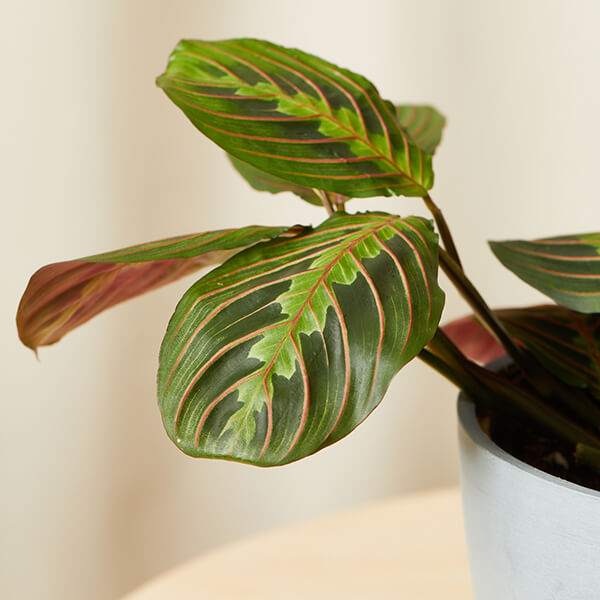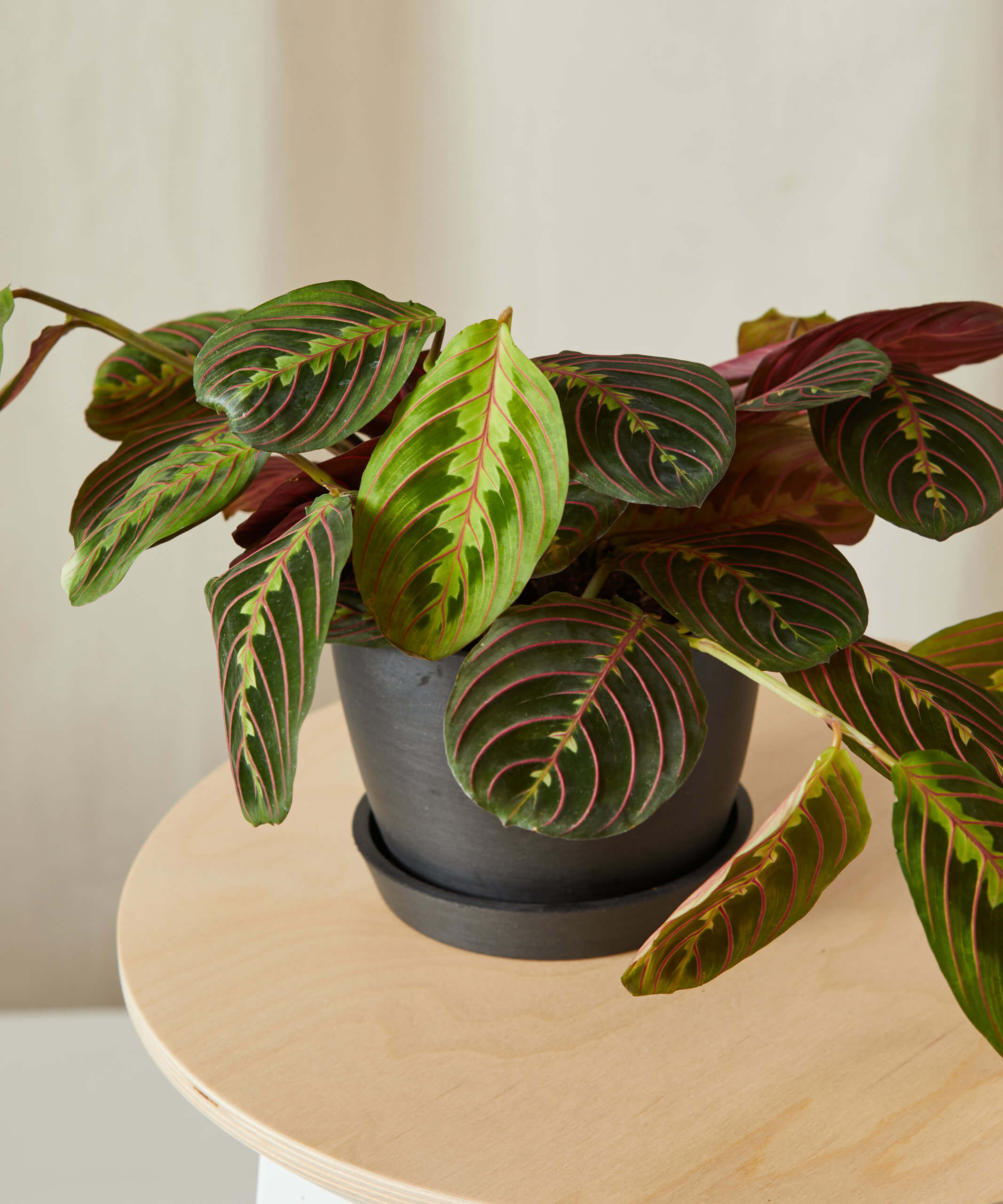Prayer plants, also known as Maranta leuconeura, are beautiful houseplants prized for their brightly colored, variegated leaves. However, it’s common to notice the leaves on your prayer plant begin curling up at some point. Curled leaves on a prayer plant are generally a sign that something is wrong and the plant is under stress. Thankfully, identifying the cause and adjusting care is usually all that’s needed to rehab curled prayer plant leaves back to health.
What Causes Curling on Prayer Plant Leaves?
There are four primary causes that can lead to prayer plant leaves curling up
- Underwatering
- Low humidity
- Insufficient light
- Cool temperatures
When prayer plants lack adequate moisture, humidity, light, or warmth, the leaves will start curling up from the edges inward as a stress response. Other signs of stress include leaves drooping, browning, or yellowing.
New growth emerging with curled leaves is normal, but mature leaves suddenly curling indicates a growing condition that needs intervention. Address any underlying care issues promptly to prevent lasting damage or loss of leaves.
How to Fix and Prevent Curled Prayer Plant Leaves
If you notice curled leaves on your prayer plant, review each aspect of care and make adjustments as needed:
Water thoroughly Prayer plants like their soil to stay consistently moist. Check the soil daily by poking your finger into the top few inches, and water whenever it is partly dry. Soak the soil completely until water drains freely from the drainage holes on the bottom
Increase humidity. Prayer plants thrive in humidity above 50%, and closer to 60-70% is ideal. Use a humidifier, pebble tray, or grouping with other plants to boost moisture in the surrounding air.
Provide bright, indirect light. Place your prayer plant near an east or west facing window where it will receive 3-4 hours of gentle sunlight filtered through sheer curtains each day. Rotate the plant periodically to prevent lopsided growth toward the light.
Maintain ideal temperatures. Prayer plants grow best with temperatures between 65-80°F. Keep the plant away from hot vents, cold drafts, and windows that may get chilly at night during winter.
Fertilize regularly. Use a balanced liquid fertilizer, diluted by half, every 2-4 weeks during the active growing season in spring through summer. Reduce feeding in fall and winter months.
Treat pests. Inspect closely for signs of insects like webbing, stippling damage, or visible bugs which can cause leaves to curl. Treat any infestations found promptly and isolate the affected plant.
Use filtered water. Chlorine and fluorine in tap water can build up in the soil over time and damage leaf health. Allow water to sit out overnight before using to dissipate these chemicals.
What Healthy Prayer Plant Growth Looks Like
When you meet its care needs, a happy prayer plant will showcase:
- Flat, outward extended leaves during the day
- Leaves folded upright at night
- Vibrant green leaves with bright variegation
- No brown tips, spots, damage, or curled edges
- Perky, upright stems and new growth emerging
- Moist but not soggy soil
Troubleshooting Severely Curled Prayer Plant Leaves
If your prayer plant has leaves that remain tightly curled even after adjusting care, try these extra revival steps:
-
Prune off any shriveled and damaged leaves to focus the plant’s energy on new growth.
-
Take stem cuttings of any still healthy leaves to propagate and start over with a fresh plant.
-
Remove the entire plant and place the root ball in a vase of water until new water roots form. Repot in soil once roots are over an inch long.
-
Repot in fresh, well-draining soil if the original soil has poor aeration or retains too much moisture.
Don’t give up too quickly! With time and diligent care methods, even severely curled up prayer plant leaves can unfurl and regain their strength.
How to Prevent Future Leaf Curling
Consistency is key when caring for prayer plants. Maintain proper watering, humidity, light, temperatures, fertilizing, and pest monitoring at all times to avoid stresses that can cause leaves to curl up. Other helpful tips:
-
Allow space between plants for good airflow.
-
Use filtered or distilled water rather than tap water.
-
Keep the plant away from dry heat sources.
-
Prune off spent foliage and blooms to focus energy.
-
Avoid disturbing or moving the plant unnecessarily.
Enjoy Your Prayer Plant’s Beautiful Foliage
With their stunning striped and variegated foliage, prayer plants are prized houseplants but require attentive care. If you notice your prayer plant’s leaves curling up, examine each aspect of care and make adjustments to get it back on track. Proper water, light, humidity, and temperatures along with fertilizer and pest treatments will have your prayer plant back to health. Consistent and proper care will keep the leaves flat, lush, and vibrant for years of enjoyment.

The leaves on your Prayer Plant could be curling for a number of reasons. Let’s investigate and get to the bottom of this!

Incredibly dry soil
Your Prayer Plant prefers soil that is consistently moist. Be sure you’re not over or underwatering your plant. Keep a consistent watering schedule–water when 25% of the soil volume is dry.
If you accidentally let your Prayer Plant’s soil dry out completely, you may see leaves go limp, droop, and possibly start to brown and curl. If the soil is extremely dry all the way through the pot, a thorough soak is in order.
Here’s how to soak-water your Prayer Plant:
- Place your plant in your sink or tub without the saucer. Fill your basin up with about 3-4″ of water. Make sure the water isn’t hot!
- Allow your plant to soak up water through the drainage hole in the bottom of the pot for at least 45 min.
- Feel the top of the soil after your plant has been soaking–has the water reached the top 2-3” of soil?
- If not all the soil feels saturated, water your Prayer Plantslightly from the top of the soil to help speed up the saturation.
- When your plant’s soil is evenly damp, drain the sink/tub and allow the plant to rest while it drains thoroughly. Place the plant back on its saucer and back in its proper spot.
Water quality
If the curling continues after you’ve regulated a watering schedule, another common reason your Prayer Plant’s leaves are curling could be due to your tap water. Tap water contains salts, chlorine, minerals, and fluoride – all of which can build up in the soil of your plant causing the tips of the leaves to burn, turn brown, and curl up. One way you can remedy this is to use a water filtration system. If you do not have a filtration system available, leaving your water in an open container or sink overnight before using can help relieve some of the chlorine.
Temperature
Make sure your plant is not in a drafty area or in the path of heating and cooling vents. Leaves will curl if the plant is cold, or excessively dry from constant warm airflow.
Not enough humidity
Your Prayer Plant is a tropical plant, so it will thrive in more humid environments. Increase the humidity around your plant by misting the leaves on a regular basis, using a pebble tray, or moving a humidifier nearby.
New Growth
If you notice tight curling leaves, this may be normal. New growth forms as curled leaves that eventually unfurl into mature broad leaves.

How do you fix Calathea leaves curling ?
FAQ
Can prayer plant leaves uncurl?
As new leaves emerge from your prayer plant, they will form in a curled tube and slowly unfurl as they continue to develop. “This is nothing to worry about and to be expected from your foliage, says Hancock.
How do you fix curled Calathea leaves?
The leaves on your Calathea can curl for several reasons, but the most common culprit is dry soil. Your Calathea loves soil that stays nicely moist, so it’s best to avoid overwatering or letting it dry out too much. A good rule of thumb is to water when the top 1 to 2 inches of soil feel dry.
What does an overwatered prayer plant look like?
An overwatered prayer plant will exhibit several noticeable signs, including yellowing leaves, mushy stems, and potential root rot. The leaves may also develop brown patches, particularly at the tips, and show signs of wilting or drooping.
How to fix curled up leaves on plants?
The most common causes of indoor leaves curling upward are too little water, low humidity, insufficient light, or high temperatures. Verify the plant’s soil is not dry. Increase watering frequency, mist leaves, move to brighter indirect light, and keep away from heat vents.
